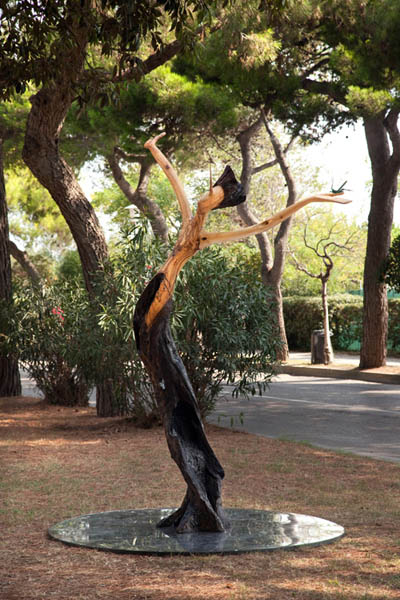Italy
Andrea Ciampini
If there is an artist, whose look corresponds to the works produced by his hands, that is Andrea Ciampini. The Tuscan sculptor has the appearance of a thoughtful boy, which will probably stick with him for ever, but in the depth of his eyes he still has a mischievous air. Even though he has been living in Volterra, the homeland of alabaster, for a long time, he carves wood, and more precisely he uses wood to give create timeless fairytale characters. The figure most frequently encountered in his recent production is Pinocchio. In Ciampini’s works of art the world’s most famous toy comes back as a puppet-child struggling with the rules of adults, which he does not understand and does not want to accept. Therefore Pinocchio embodies the freedom of nature against the coercions of the adult world. But we cannot forget that the creature invented by Collodi is double-sided. As in all stories with a moral background, the wooden boy has a positive side, which consists of imagination and good intentions, and a negative side, which consists of arrogance and lying. These are all aspects which Ciampini has analysed and included in a number of works of art, each showing a different side of Pinocchio’s nature, starting from Pinocchio (2005), to Prima bugia (2007), up to Monello (2009). In Coscienza dell'Io, which is exhibited at OPEN 12, the artist investigates a new element: the theme of will, which may turn to stubbornness, within the absolute freedom that childhood thrives on. Struggling with the discovery of the external world, when the Talking Cricket orders Pinocchio to study and take up serious things, he answers, “...It’s much more fun, I think, to chase after butterflies, climb trees, and steal birds’ nests...”. (from: Le avventure di Pinocchio, Collodi, 1881). In the sculpture created for OPEN 12 the puppet has got no legs to climb trees, and his feet still need to be rough-hewn, because his carpenter-father has not yet decided to allow him to move at will. Yet his arms are wide-open in the air to catch everything within reach. This work symbolizes man in his embryonic state, with an intact hope of discovery, waiting motionless until he can begin to walk with his own legs. When this happens, the choice will be immediate and inevitable. A direction must be followed. A decision about what to do with oneself must be taken. And after setting out, it will not be possible to turn back. This huge olive tree, out of which Ciampini has carved this change from chrysalis into insect, which is a metaphor suitable for any living being, was promised him some time ago by a friend who had to fell it. It was left to dry on the edge of the wood where it grew for many months. Then, as in every respectable fairy tale, it came back to life clothed in another story.
Text by Anna Caterina Bellati
